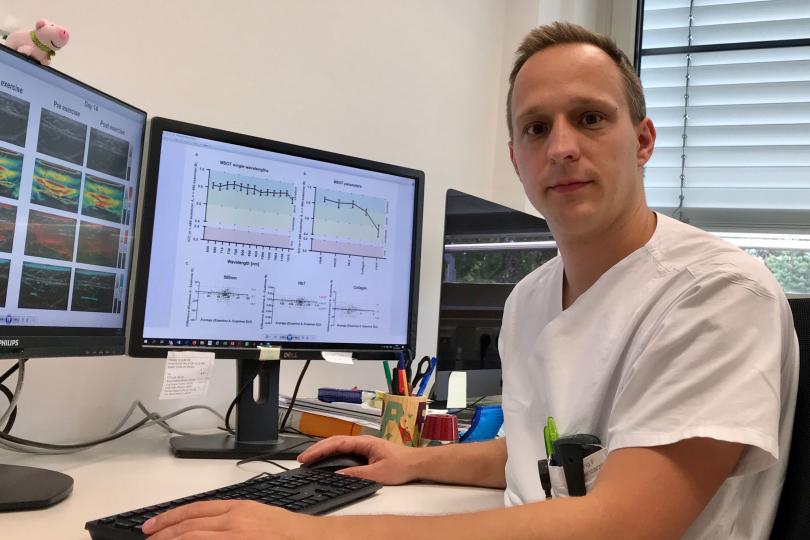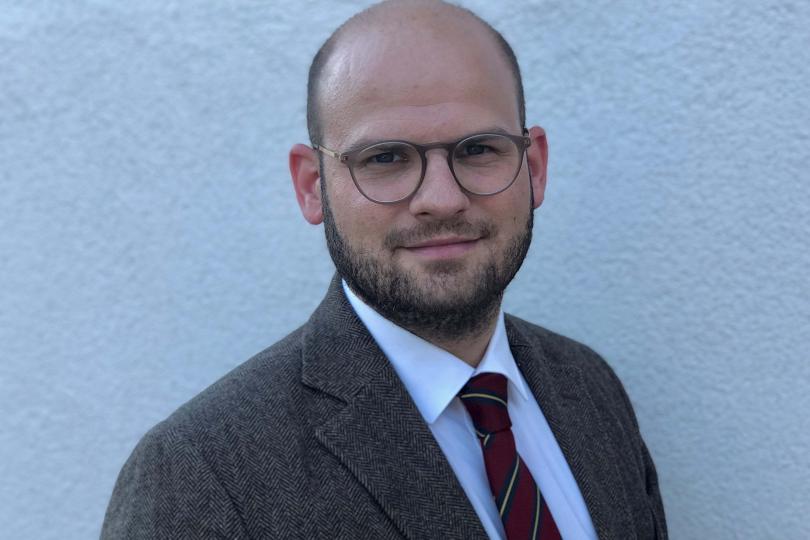
This special distinction is being received by the three next-generation scientists Dr. Ferdinand Knieling,
Dr. Florian Kahles and Dr. Sven Borchmann. Each of the prizes is endowed with EUR 10,000 for use at the prizewinner’s personal discretion.
All of the next-generation scientists funded by EKFS within the medical/scientific funding lines First and Second Application, Else Kröner Memorial Fellowships and Else Kröner Advancement Programmes were able to submit entries for the prize. Prerequisite to submission was that the publication arose from foundation funding and was published in 2019.
Alongside the journal impact factor, decisive for evaluation by the Scientific Commission was the outstanding scholastic work in conjunction with the career path until now. Within the framework of alumni work being newly implemented into work at the foundation, EKFS shall be announcing a call for competition for the Publication Prize on an annual basis.
Three next-generation scientists are being honored with the Publication Prize 2020:
Dr. Ferdinand Knieling, M.D., Center for Pediatric and Adolescent Medicine, University Hospital Erlangen, for his paper in Nature Medicine 2019; 25:1905-1915
In the fall of 2018 he received an Else Kröner Memorial Fellowship for his project “Light in – Sound out. New, non-invasive biomarkers in pediatrics.”
In my research project I focus on hereditary muscular diseases, some of which take a severe course, that in future potentially might be able to be treated using new genetic therapies. By working with one of the most frequent inherited myopathies we were able to show that the disease’s progression could be tracked very easily using a non-invasive method. In the case of multispectral optoacoustic tomography (MSOT), a transducer is placed on the skin and, instead of sound, energy is conducted to the tissue by means of flashes of light. This leads to a constant alternating of minimal extensions and contractions of individual tissue components whose acoustic signals can be imaged as a result. During the work our group at the Center for Pediatric and Adolescent Medicine was able to demonstrate that the pathological muscular conversion can be depicted within a few seconds, both in the model and in the case of patients with Duchenne muscular dystrophy. In future this could enable changes in muscles and the effectiveness of therapy to be detected within a few seconds.
I began my studies in 2010 in the Medical Clinic 1 at University Hospital Erlangen. Sonography delighted me so much that I interrupted my studies of medicine for a year abroad at Stanford University from 2012 to 2013. After completing my course of studies in 2014 I began with specialist training, a residency at the Center for Pediatric and Adolescent Medicine in Erlangen. From 2016 to 2017 I was a participant in the research rotation at the Interdisciplinary Center for Clinical Research (IZKF). Post-doctoral qualification ensued in 2018 and I became the head of a next-generation group. Acceptance to the Clinician Scientist Program and parallel commencement towards a doctorate in Human Biology occurred in 2019.
Today pediatrics readily makes a specialty-transcending and interdisciplinary treatment of children and adolescents possible, although what’s often missing is that medical innovation and research are not being taken into account. That’s why viable, future-proof pediatrics needs a broadly based public perception and acceptance, as well as social value creation that goes beyond the concept of economic efficiency.
Dr. Florian Kahles, Clinic for Cardiology, RWTH Aachen, for his paper in the European Heart Journal 2019, Oct. 16 pii: ehz728. doi: 10.1093/eurheartj/ehz728
Dr. Florian Kahles headed the project “The role of the incretin hormones GLP-1, GLP-2 and GIP in septic cardiomyopathy” from 2017 to 2019 in a capacity as First Applicant.
Glucagon-like peptide 1 (GLP-1) is an intestinal incretin hormone that is secreted following the ingestion of food and is involved in regulating blood glucose. GLP-1 receptor agonists are utilized towards treating diabetes mellitus on a clinically successful scale and displayed an improvement of the cardiovascular prognosis for these patients in large-scale studies. We studied the endogenous GLP-1 system within the framework of cardiovascular diseases and were able to show that patients who had a heart attack exhibit an elevated GLP-1 level, that GLP-1 strongly correlates with inflammatory markers such as hsCRP hereby and is a very good biomarker for these patients’ cardiovascular prognosis. Even after adjusting for a variety of pre-existing conditions, risk factors and risk markers in complex statistical models, the association between GLP-1 levels and the prognosis remained significant and revealed itself in the case of patients with diabetes mellitus and those who did not have the disease. In the process GLP-1 proved itself to be superior to other established risk markers and led to an improved validity of the GRACE risk score utilized daily in the course of everyday work at the clinic.
Following the first state examination in 2011 while I was still studying medicine, I began my scientific activity as a doctoral candidate in the work group headed by Prof. Michael Lehrke and Prof. Nikolaus Marx in the Medical Clinic I (cardiology, angiology and internal intensive care medicine) at University Hospital Aachen (UKA). I interrupted the course of studies for 12 months to pursue full-time work at a laboratory. I received my doctorate in 2015 and began my clinical activity in cardiology at UKA. From 2017 to 2020 I worked in a capacity as postdoctoral research fellow at Harvard University in Boston in the USA. Since April 2020 I have headed my own work group in the Cardiology Clinic at University Hospital Aachen.
Especially for young physicians it is becoming increasingly harder to find sufficient time for research alongside clinical work on a ward, and then additionally be able to arrange this combination together with a family without neglecting one of these pillars in the process. The consequence is that young colleagues, both men and women, frequently have to give up performing research. My wish is that in future ways, means and programs are created which are better at making this combination possible.
Dr. Sven Borchmann, M.D., Clinic I for Internal Medicine, University Hospital Cologne, for his paper in the Journal of Clinical Oncology 2019, Dec. 20; 37 (36): 3528-3537
In 2018 Dr. Sven Borchmann was accepted into the research advancement program “Clonal evolution in cancer” at the University of Cologne headed by Prof. Hans Christian Reinhardt. The abovementioned publication inter alia arose from this funding.
Vitamin D deficiency has been readily described as a modifiable risk factor for the occurrence of many frequent types of cancer, though the same applies for successful treatment. Whether this risk factor plays a role in the case of Hodgkin lymphoma hasn’t been answered yet.
At first we conducted a study in which the vitamin D level was measured in patients with Hodgkin lymphoma prior to treatment and then put into context together with the treatment outcomes. 50 percent of the patients had a vitamin D deficiency prior to scheduled chemotherapy. Patients with vitamin D deficiency had a shorter disease-free period following therapy and a lower overall rate of survival as well. We have consequently shown that Vitamin D status is an independent predictor for treatment outcome. In a variety of disease models at the laboratory we subsequently demonstrated that vitamin D distinctly reinforces the growth-inhibiting effect of chemotherapy in the case of Hodgkin lymphoma and by doing so discovered a potential mechanism that explains our findings.
After completing my German A-levels to be able to go to a university I initially studied economics, not medicine, so that my path to medicine ended up being my second choice of a profession at first, so to speak. During the course of studying medicine I realized at an early stage what had already bothered me while studying economics: We have no solid scientific basis for many points of view and the conclusions drawn from them, some of which are quite serious. During the work on my doctoral thesis at the lab headed by Prof. Elke Pogge von Strandmann I learned the basic principles of scientific work in the biomedical laboratory. Following my entry into the profession I worked on clinical study projects within the German Hodgkin Study Group under the direction of Prof. Andreas Engert and, as a result, accumulated experience in clinical research. I am currently working on establishing a work group of my own. I would like to use this to assist in developing solutions for relevant medical problems in the field of oncology. As a physician performing research, I believe it’s a role where one can generate a great deal of benefit for the community at large, because you’re predestined to link hands-on, in-practice relevance and rigorous scientific methodology with one another.
My wish is that the professional image of a physician doing research receives greater acknowledgment and, as a consequence, more long-term career perspectives for a combined clinical and research function are created at German institutions of higher education. From my point of view, concrete measures implementable here on a short-term basis are: the unbureaucratic recognition of research periods for advanced specialist training bearing an immediate relevance to practice; comprehensive, unbureaucratic child care in order to help with the triple challenge of clinic, research and family during decisive career-shaping years; the creation of distinctly more, possibly even fixed-term professorships that guarantee a safeguarding of research and training time in the long term; and unbureaucratic support for spin-offs and the utilization of research findings in order to strengthen the application of research findings in clinical practice.
You can find additional information in our press release.


